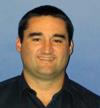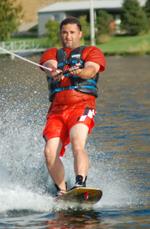Treatment
Patient Story: Hip Resurfacing

Firefighter Kenneth Knott's job relies on his ability to move heavy equipment and carry injured patients down stairs and through rough terrain. Also a member of the Mercer Island SCUBA rescue team, Ken performs rescue dives. Outside of his heavily physical job, Ken is an avid outdoorsman and participant in multiple sports.
Four years ago, Ken began experiencing pain in his hips. He first noticed discomfort while walking. "Over the course of the first year, I continued to have more pain, to the point that I was unsure if I could continue to work," he remembers. Eventually, Ken's hip pain progressed to the point where it was interfering with his job. "I continued to work but had to find new ways to do my job to mitigate the pain. I often had to depend on my fellow workers to take some of the workload because I was unable to move in certain directions and had pain on a number of movements."
Eventually, Ken made an appointment with Paul Manner, MD, FRCSC, an orthopaedic surgeon at the University of Washington Orthopaedics and Sports Medicine clinic. Dr. Manner, who specializes in adult reconstruction and joint replacements, took x-rays of Ken's hips and diagnosed him with osteoarthritis of the hip.
Osteoarthritis, also known as "wear and tear" arthritis, is a common condition where the cartilage on the ends of the bones wears thin. Articular cartilage helps joints, like the hips, glide smoothly. Osteoarthritis is degenerative, and often progresses rapidly, creating painful bone-on-bone contact. About ten million Americans suffer from osteoarthritis.
Ken was informed that his only option was total hip replacement. However, because of his age, Dr. Manner recommended that he postpone the surgery until he was older. Eventually, Ken's pain progressed to a point where he was unable to work, had difficulty walking, and was unable to exercise to stay in shape. He was looking toward his future with little hope for improvement.
In December of 2010, Dr. Manner performed a hip resurfacing procedure on Ken's left hip, a more conservative approach to total hip replacement which leaves the femur bone intact. With hip resurfacing surgery, if a revision procedure is required, there is bone remaining for the stem of a total hip replacement implant.

Ken felt relief almost immediately. He was able to fully return to his job functions after five weeks of physical therapy. A little over one year later, in January of 2012, Dr. Manner resurfaced Ken's right hip. "After having both hips resurfaced, I have no pain," Ken says with pride. "I am able to do my job at the level I was prior to the first symptoms. Without this surgery I would not have able to continue working in the career that I love and providing for the citizens that depend on our services."
Ken aspires to serve his state and his country as a firefighter for the next ten years. He aims to live life to the fullest and has already started biking again. He intends to return to snow skiing and water skiing this year.
"I hope to get 20+ years from the implants and at that time, I hope to be able to replace them with full replacements," he says. Advancements in research have already enabled Ken and others suffering from osteoarthritis. Ken hopes to see further advancements in the diagnosis and treatment of degenerative joint disease. "This surgery has truly changed my life."
Last Reviewed
October 2012
AAOS does not endorse any treatments, procedures, products, or physicians referenced herein. This information is provided as an educational service and is not intended to serve as medical advice. Anyone seeking specific orthopaedic advice or assistance should consult his or her orthopaedic surgeon, or locate one in your area through the AAOS Find an Orthopaedist program on this website.






